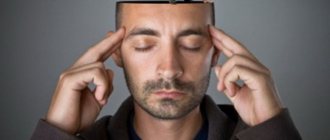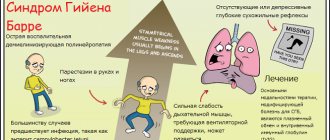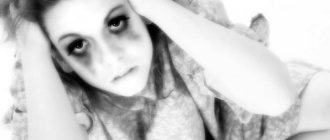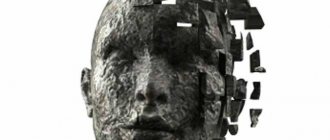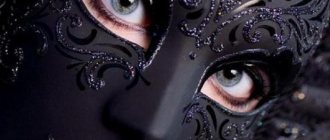Mental automatism, which in medicine is better known as Kandinsky-Clerambault syndrome, belongs to the category of severe mental disorders. This pathology manifests itself in the form of disorders associated with emotional and sensory perception of the surrounding world. In addition, the development of the disease is accompanied by impairments in the intellectual sphere. Patients with this disease are firmly convinced that their consciousness is influenced by extraneous forces. Kandinsky-Konovalov syndrome occurs due to delusional ideas and attacks of hallucinations. Many patients experience unbearable suffering, thinking that their difficulties in life are associated with the influence of aliens, radiation exposure or damage. Below we propose to consider the features of the disease known as mental automatism.
Kandinsky-Clerambault syndrome is the most common manifestation of schizophrenia
Causes of mental disorder
The disease in question is one of the most severe types of complications, various mental disorders. According to medical data, Kandinsky syndrome is most often formed under the influence of various forms of psychosis, obsessive-compulsive disorder and schizophrenia. Much less frequently, the causes of mental automatism are traumatic brain injuries, cancer, toxin poisoning and drug addiction.
Experts say that the above-mentioned conditions have an increased impact on the human psyche, which leads to the launch of protective processes. It is these protective processes that manifest themselves in the form of automatism. The vast majority of patients with this diagnosis have a sensory form of the disease, which is characterized as a search for justification for traumatic events in the form of external influence.
Notes
- B. D. Tsygankov, S. A. Ovsyannikov.
Psychiatry: a guide for doctors. - M.: "GEOTAR-Media", 2011. - P. 17. - 496 p. — ISBN 978-5-9704-1905-2. - ↑ 12345678
Zharikov, Tyulpin, 2002, p. 114. - ↑ 12
Kerbikov et al., 1968, p. 97. - Kerbikov et al., 1968, p. 99.
- Zharikov, Tyulpin, 2002, p. 70.
- ↑ 12
Zharikov, Tyulpin, 2002, p. 115.
Forms of mental automatism
The mental disorder in question is divided into the following types:
- Kinesthetic form – motor automatism.
- Senestopathic form – sensory automatism.
- The associative form is ideational automatism.
In addition to the above-mentioned types of disease, experts distinguish inverted and hallucinatory types of pathology, which are much less common.
Associative form
With this form of the disease, there is an imaginary effect on mental perception and intellectual activity. A characteristic clinical manifestation of this type of mental automatism is mentism, which manifests itself in the form of an uncontrolled mental flow. It should be noted that the patient is firmly confident that the people around him hear his thoughts.
Also, this form of the disease is characterized by the voicing of thoughts by an “extraneous voice” that appears in the patient’s head. At the initial stages, the voices are pronounced quite quietly, but over time they become distinct. This symptom affects the disappearance of thoughts. Experts point out that, being in such a situation, the patient is firmly convinced that all the thoughts born of his consciousness do not belong to him. Many patients complain of dreams that are controlled by external forces. The associative form of pathology is accompanied by an increase in suggestibility. If a patient is shown a drawing of a certain event and told that he was a participant in it, false memories will begin to appear in the patient’s head.
Most patients with this form of mental automatism are firmly convinced that their behavior, feelings and emotions belong to “higher” forces that control their lives.
Mental automatism syndrome is a type of paranoid-hallucinatory disorder
Perception disturbance
Kandinsky-Clerambault syndrome in this form is expressed in the form of unpleasant and strange feelings that are caused by the pressure of external factors. During an attack, symptoms such as fever and pain are observed. Pain with mental automatism has the form of pulsation, bursting or twisting of the limbs.
Motor disorders
In the case of this type of disease, a person is firmly convinced that all his body movements are the result of the control of external forces. Such obsession manifests itself in the form of complaints about the inability to independently control motor functions. It is a fairly common situation in which the patient feels that his tongue is not under control.
Delusions and hallucinations
This type of disease is divided into several subgroups: delusional and hallucinatory symptoms. In the case of delusions, the patient is in the grip of ideas associated with delusions of influence or persecution. In the hallucinatory form of mental automatism, these ideas are weakly expressed or completely absent. It is important to note that in the case of attacks of hallucinations, there is a complete absence of delusional thoughts.
Inverted form
The difference between this form of the disease and the above is that the patient believes that he has the ability to control the behavior of people around him. The development of pathology leads to a clear confidence in the ability to influence the thoughts or feelings of people. A specific symptom of this disease is an overestimation of one’s own personality, which can be expressed by delusions of grandeur, which is characteristic of paraphrenia.
Hallucinatory-paranoid form of the disease
The syndrome of mental automatism, expressed in a hallucinatory-paranoid form, has an acute development and has a tendency to transform into a chronic pathology. The acute development of mental disorders is not characterized by systematization of symptoms. Most often, this type of illness manifests itself in the form of groundless fear and attacks of catatonia, which are accompanied by symptoms of other forms of mental automatism.
In the case of a chronic form of hallucinatory-paranoid disorder, the delusional syndrome has a systematic character, which leads to a decrease in anxiety and confusion. It is important to note that the symptoms of this disease develop gradually. At a certain stage of development, the patient begins to strive for social isolation, since he is firmly convinced of external influence on his behavior.
With this disease, obsessive states appear, which are based on the idea of outside influence
Diagnostics
Diagnostic measures are aimed at identifying the main cause that could lead to the formation of hallucinatory visions. Be sure to clarify the provoking factors, the presence of bad habits, collect a thorough medical history, talk with relatives to identify hereditary predisposition. After carrying out basic diagnostic procedures (general and biochemical blood tests, general urinalysis, MRI, CT, ultrasound of organs and systems as necessary), a consultation with a specialist is required. If there is a drug or alcohol hallucinatory syndrome, then such patients are treated by a toxicologist. For neurotic conditions - a psychotherapist or psychiatrist. In case of organic brain damage - a neurologist and oncologist. If no somatic pathology has been detected, and the symptoms are clear and represent Kandinsky-clerambault syndrome, then such patients are treated by a psychiatrist on an inpatient or outpatient basis, which will depend on the severity of the process.
Clinical picture
Symptoms of motor automatism manifest themselves in the form of constrained movements, disturbances in the functioning of the speech apparatus and atypical gestures or facial expressions. Mental disorder is the main reason for the emergence of thoughts that a person’s life proceeds under the constant control of external forces that control the patient’s behavior. At a certain stage of pathology development, changes in the functioning of the speech and musculoskeletal system are observed. Many patients often encounter situations where the disease “forces” them to utter negative and offensive words towards others. Those who are ill try to justify such behavior by the influence of external forces.
Ideatorial automatism is closely related to disturbances in the mental perception of the surrounding world. Many patients are firmly convinced that people around them hear their thoughts, steal ideas, or closely monitor their internal dialogue. The development of the disease leads to a gradual loss of control over one’s own behavior and feelings. Patients try to justify their negativity by the influence of extraneous voices that control their movements and thoughts. According to experts, many patients experience the presence of obsessive thoughts, which the patient feels belong to outside forces.
Sensory disorder manifests itself in the form of clinical symptoms that are pseudohallucinatory in nature. The vast majority of patients experience painful attacks for which there is no rational explanation. It is important to pay attention to the fact that patients have difficulty indicating a clear location of pain. According to patients, pain is expressed as a feeling of pulsation, squeezing or burning and often changes location, smoothly flowing throughout the body. Many patients believe that attacks of pain are caused by the influence of otherworldly forces.
The syndrome can develop in two forms: acute and chronic
Symptoms of Kandinsky-Clerambault syndrome
The disease manifests itself in acute attacks that last 2-3 months. Hallucinatory-paranoid syndrome is accompanied by symptoms in the following forms:
- constant headache;
- increase in speech activity;
- increased excitability of the nervous system;
- inability to specify the causes of concern;
- manifestation of signs of external control of consciousness;
- illusions of manipulations with mental activity;
- the presence of numerous fears and panic (delusions of persecution);
- unnatural body movements;
- automaticity of actions.
Specific Features
Mental automatism belongs to the category of mental diseases that have several main stages of development, each of which has specific manifestations. Each stage of the disease is characterized by certain clinical manifestations and degrees of severity. The course of the disease is divided into two types:
- acute type;
- chronic form.
During the acute course of the disease, most clinical signs are pronounced. It should be noted that most patients are in an active state for a long period of time and are very friendly to others. However, such behavior is accompanied by mild irritability and groundless aggression. In some situations, patients experience phobias and panic attacks. The average duration of development of the disease is from thirty to ninety days. During this time, the patient develops pseudohallucinations, which are accompanied by delusional syndrome.
The presence of delusional ideas leads to clouding of consciousness, which affects the conduct of a normal lifestyle. Many patients experience a gradual transformation of primary symptoms, which leads to a change in the localization of pain and a worsening of the obsessive state.
The chronic type of the disease develops over several years . Ideatorial automatism is one of the characteristic manifestations of the first stage of development. Further, signs of sensory or kinesthetic forms of the disease are added to the existing symptoms. It is important to note that the symptoms of a chronic disease are mild, which greatly complicates diagnostic measures. According to experts, many symptoms characteristic of delusional syndrome also have a mild degree of severity. This feature of the disease leads to the need to use differential diagnosis.
It is possible to prevent the development of this syndrome in patients by ensuring proper treatment of the diseases that cause this condition
Delusional – hallucinatory type of course
In this case, several options for the course of the disease are provided: delusional and hallucinatory:
- with the delusional variant of the course, a person develops various kinds of delusional ideas of persecution, influence, and pseudohallucinatory disorders, in turn, manifest themselves to a lesser extent or may be completely absent;
- whereas in the hallucinatory course , pseudohallucinations are observed, and there are practically no delusional disorders.
Treatment and psychotherapeutic correction
Therapeutic measures for mental automatism are complex. In addition to drug treatment based on the use of antidepressants and drugs from the antipsychotic group, various psychotherapeutic practices are used. It is important to note that after treatment, the patient will face long-term rehabilitation.
In the presence of concomitant diseases in the form of neurotic disorders or psychosis, therapeutic treatment is carried out in a clinical setting under close medical supervision.
It is worth noting that the duration of rehabilitation may vary. The basis of the rehabilitation period is psychotherapeutic correction, physical therapy sessions and adherence to the correct diet. The patient must follow a strict diet throughout the entire recovery period, excluding from the daily diet all products that contain copper.
To reduce the likelihood of relapse, the patient should pay great attention to his physical activity. Moderate exercise, walks in the fresh air and visiting the pool can improve your well-being. Relatives of a person with a mental disorder should be aware of the importance of understanding and support during this difficult period. Caring for a loved one can not only have a beneficial effect on their emotional state, but also reduce the time required for recovery.




